This year, we will have a couple of flagship 5G smartphones and most of them will use 5nm and 6nm chips. Over the past three months, we have seen the release of multiple flagship smartphone processors all of which support 5G. While we thought that this year's flagship will strictly be for 5nm and 6nm chips, Qualcomm has a flagship processor that uses the 7nm manufacturing process (many will call this a pseudo flagship processor). Interestingly, since November 2020, the three major chipmakers - Qualcomm, MediaTek, and Qualcomm have all released two flagship processor. For now, these are the top processors for 2021 5G smartphones. Let us take a closer look at these chips. Please note that they are not arranged in order of performance. Instead, we discussed the 5nm chips, then 6nm before the 7nm chip.
Samsung Exynos 1080 (Samsung 5nm) - Launch Date: November 12, 2020
This time, the Exynos 1080 processor uses a new CPU architecture core. This chip uses the Samsung's 5nm EUV process as well as the 1 + 3 + 4 architecture. It comes with one 2.8GHz A78 large core for peak performance, three 2.6GHz A78 cores for balanced processing, and four 2.0GHz A55 medium cores for efficiency. It also integrates millimeter-wave dual-mode 5G. Its single-core performance increased by 50% while the multi-core performance increased nearly twice.
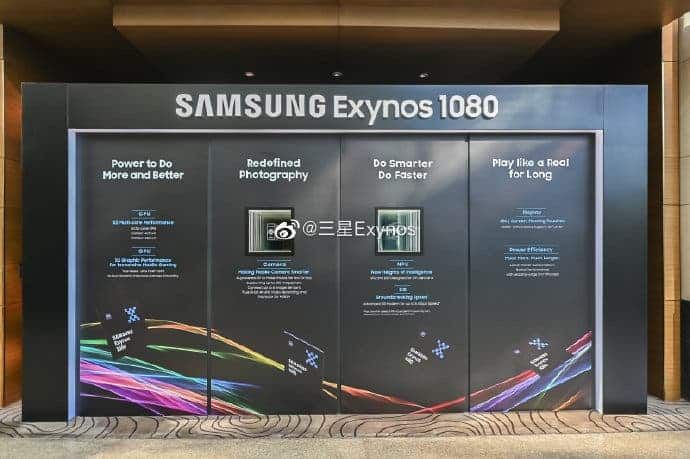
Exynos 1080 is Samsung’s first mobile processor using the most sophisticated 5nm EUV FinFET process technology. This chip uses Samsung's latest 5G module and supports up to 5.1Gbps download speed. At the same time, it supports the Sub-6GHz frequency band and the millimeter-wave frequency band. Furthermore, it supports WiFi6 and Bluetooth 5.2 technology which improves connectivity.
In order to make mobile phone photos smarter, Exynos 1080 integrates artificial intelligence technology into the ISP, and the high-performance ISP supports up to 200MP sensor. It also supports up to 6 cameras. Furthermore, this chip supports the traditional 10-bit color shooting and the ability to directly edit HDR10+ videos.
The Exynos 1080 uses the Mali-G78 GPU from ARM. Under the Manhattan v3 standard, the overall GPU performance has increased by 2.3 times. Also, the exclusive development of the Amigo power distribution program makes the high-performance gaming experience more durable.
Current 5g Smartphones
- Vivo X60 series (X60 & X60 Pro)
Samsung Exynos 2100 (Samsung 5nm) - Launch Date: January 12, 2020
Samsung recently held a global online conference where it released the 5nm chip Exynos 2100 smartphone processor. The Exynos 2100 is Samsung's first mobile chipset with integrated 5G. It is based on a 5nm EUV process (Samsung). Compared with the previous generation products using the 7nm process, the Exynos 2100 reduces power consumption by 20% and improves overall performance by 10%.
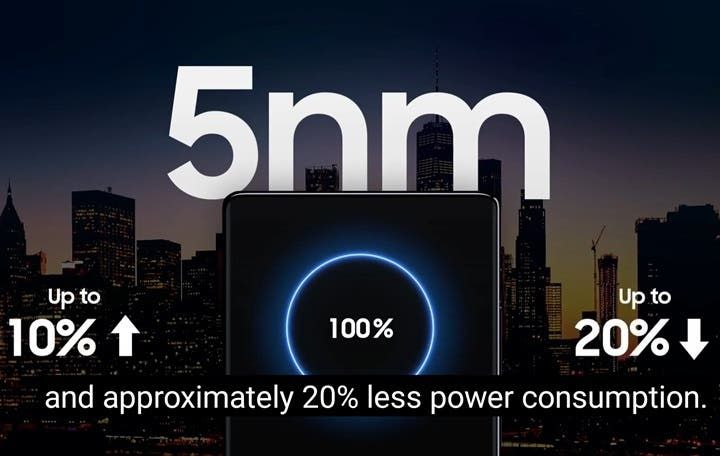
Moreover, the Exynos 2100 chip uses a three-cluster structure, including a 2.9GHz ARM Cortex-X1 super core, three Cortex-A78 cores, and four Cortex-A55 cores. Samsung said that compared with previous products, the Exynos 2100 multi-core performance has increased by more than 30%.
In addition, the Exynos2100 uses ARM Mali-G78 GPU. The latter improves graphics performance by up to 40%. This chip also supports UFS 3.1 and UFS 2.1 storage. Plus, it can work with up to 200MP camera resolution. Currently, Samsung's Exynos 2100 chip has begun mass production. As Samsung's flagship processor in 2021, the Galaxy S21 series will be the first smartphone coming with this chipset.
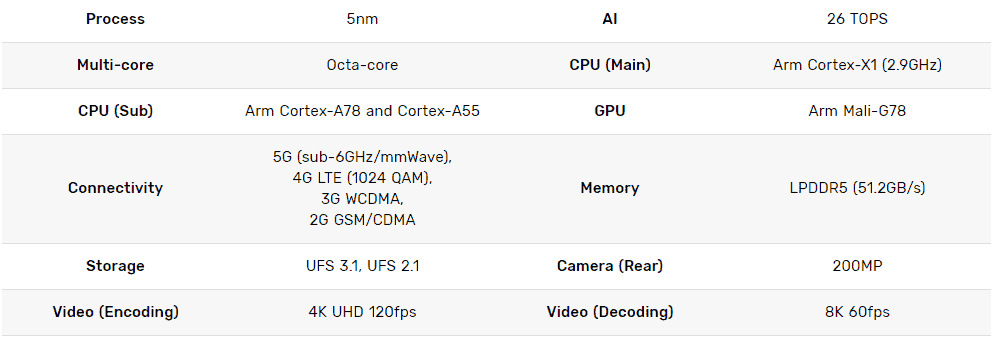
Current 5G Smartphones
- Samsung Galaxy S21 series (S21, S21+, S21 Ultra)
Qualcomm Snapdragon 888 (Samsung 5nm) - Launch Date: December 2, 2020
As the latest product of Snapdragon 8 series, Snapdragon 888 integrates Qualcomm's third-generation 5G modem and radio frequency system - Snapdragon X60, which supports all major global millimeter wave and Sub-6GHz frequency bands, as well as 5G carrier aggregation, global multi-SIM card functions, Independent (SA) and non-independent (NSA) networking modes and dynamic spectrum sharing (DSS).
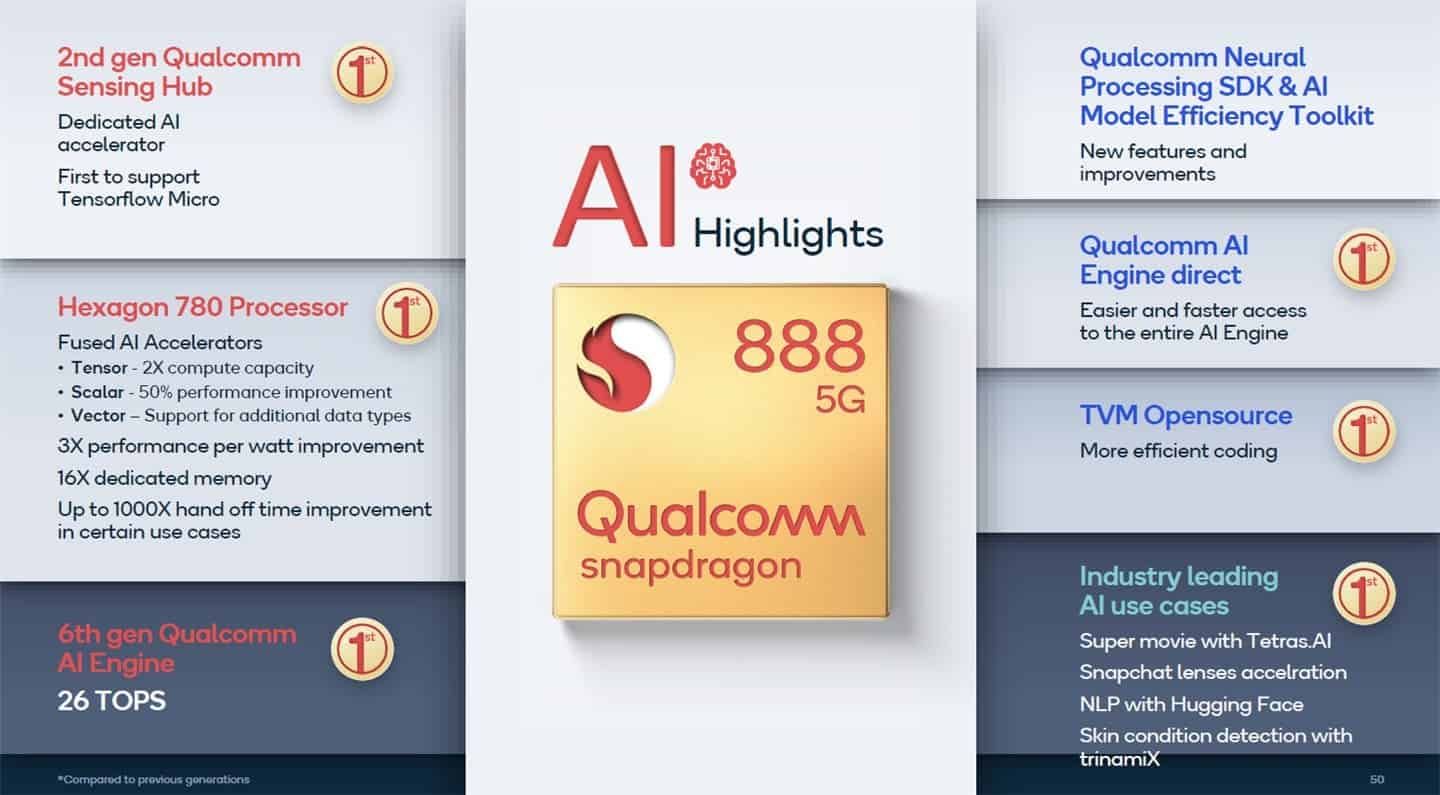
The Snapdragon 888 uses 1 x 2.84GHz (ARM's latest Cortex X1 core) + 3 x 2.4GHz (Cortex A78) + 4 x 1.8GHz (Cortex A55) architecture. The GPU is Adreno 660 and it supports WiFi 6E and Bluetooth 5.2. In addition, this chip uses Samsung's 5nm manufacturing process.
The sixth-generation Qualcomm AI engine integrated on the Snapdragon 888 5G mobile platform includes a newly designed Qualcomm Hexagon processor, with a performance of 26 trillion operations per second (26 TOPS). In terms of games, it integrates the third-generation Snapdragon Elite Gaming. Also, Qualcomm claims that this chip brings the most significant performance improvement ever made by Qualcomm Adreno GPU. It also comes with a 2nd generation Qualcomm Sensing Hub which “incorporates low-power always-on AI processing for intuitive intelligent features.”
In terms of camera performance, the Spectra ISP of Snapdragon 888 supports faster billion-pixel-level processing speeds. Users can process 2.7 billion pixels per second to take photos and videos. This is about 120 frames per second and each frame is 12MP. The processing speed is up to 35% higher than the previous generation platform.
The flagship processor also comes with the new 6th-gen AI Engine. The hexagon processor brings a considerable leap in AI performance, 26 tera operations per second (TOPS) compared to the last generation.
Current 5G Smartphones
- Xiaomi Mi 11
- iQOO 7
- Samsung Galaxy S21 series (S21, S21+, S21 Ultra)
- Vivo X60 Pro+
MediaTek Dimensity 1200 (TSMC 6nm) - Launch Date: January 20, 2021
MediaTek’s new flagship 5G SoC Dimensity 1200 was officially unveiled on January 20th. The chip uses TSMC's 6-nanometer process. The CPU uses ARM’s latest A78 core with a frequency of 3.0GHz. There are also 3 large A78 cores with a frequency of 2.6GHz and 4 small A55 cores. Officially, the Dimensity 1200 performance has increased by 22% and energy efficiency has increased by 25%.
At the press conference, MediaTek emphasized the startup speed and application download and installation speed. In terms of APU and GPU, the Dimensity 1200 also has different degrees of improvement.
The Dimensity 1200 integrates a new generation of 5G modem. Officially, this chip is the first SoC that supports 5G high-speed rail mode and 5G elevator mode. At the same time, the Dimensity 1200 adopts power-saving 5G UltraSave technology to ensure power consumption under the SA network. In addition, the chip has 5G global band bandwidth support. And MediaTek claims that its downlink speed in urban areas is 25% faster than competing products.
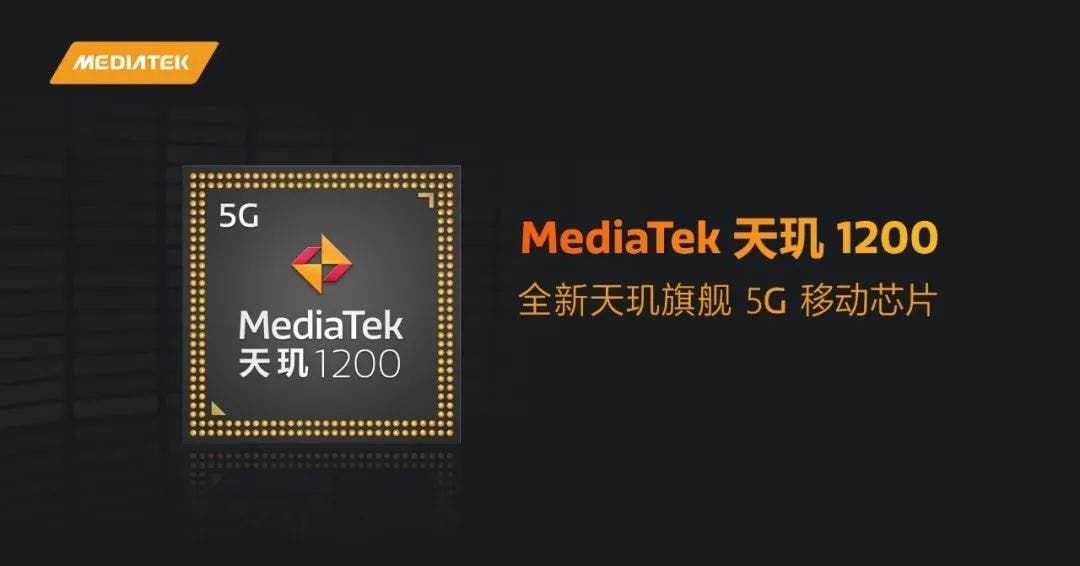
Dimensity 1200 can compete
As for photography, the Dimensity 1200 has AI speed night shooting capability. It speeds up AI computing a lot. At the same time, the Dimensity 1200 brings a super panoramic AI night shot mode. The single-frame progressive HDR video function previously unveiled on Snapdragon 888 also appeared on the Dimensity 1200. AI multi-person blur function can recognize multiple people in real-time and perform background blur; there is also a multi-depth intelligent focus function that allows the live screen to be more layered.
In terms of gaming, the Dimensity 1200 is optimized from four aspects: network, image quality, control, and intelligent load. The continuous network function of incoming calls is upgraded to 3.0. In the dual-card state, one card can be inserted to transmit data. And the other can transmit communication signals without interfering with each other. You can turn on hotspots at the same time when playing games. MediaTek is really good for high-speed rail and other game scenarios.
In terms of game image quality, the Dimensity 1200 adds a ray-tracing technology to allow virtual objects to interact with real-life ambient light and have better reflection and refraction. MediaTek will cooperate with Tencent Games' ‘Honor of Kings’ to make chip-level optimizations.
The main difference between another chip product Dimensity 1100 and Dimensity 1200 lies in the CPU architecture, GPU and APU capabilities, as well as the supported cameras and screen refresh rates.
Current 5G Smartphones
- None (Redmi K40 series rumored to use this chip
MediaTek Dimensity 1100 (TSMC 6nm) - Launch Date: January 20, 2021
The Dimensity 1100 chip uses TSMC's 6nm process technology. It has four A78 2.6GHz cores and four A55 2.0GHz cores. It integrates the ARM G77 MC9 GPU and supports dual-channel UFS 3.1.
The Dimensity 1100 includes a highly integrated 5G modem, using MediaTek UltraSave 5G technology, which has excellent energy-saving effects. In addition to supporting the latest connection functions, it also supports various generations of connection functions from 2G to 5G, including (SA) independent and dependent (NSA) 5G architecture, frequency division duplex (FDD), and time division duplex (TDD) 5G Carrier Aggregation (2CC), Dynamic Spectrum Sharing (DSS), true dual-SIM 5G (5G SA+5G SA) and 5G HD Voice (VoNR). The chipset also integrates enhancements to 5G HSR mode and 5G Elevator mode to ensure reliable and seamless 5G connections across networks.
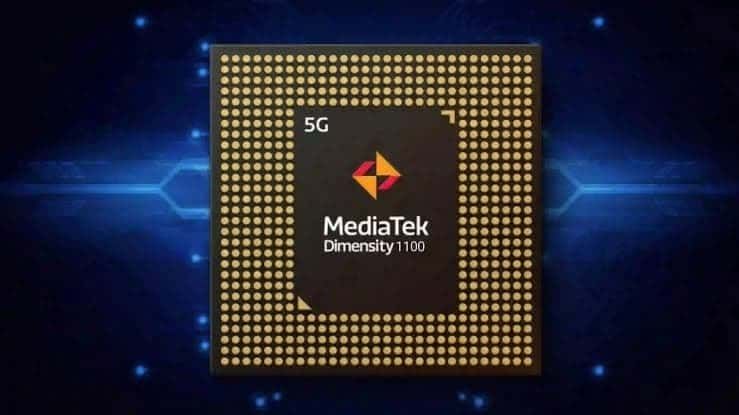
The Dimensity 1100 also includes impressive camera functions. It supports a 108-megapixel camera and integrates MediaTek’s existing APU 3.0, enabling high-performance computing and super energy-saving. Also, our protagonist supports AI camera functions, including AI panoramic night shooting, AI multi-person blur, AI noise reduction (AINR), and HDR functions. The chipset also supports new AI-enhanced video playback functions, including SDR to HDR AI.
Display and Connectivity
Apart from this, the Dimensity 1100 also supports a 144Hz refresh rate display to obtain ultra-clear, delay-free images. There is support for MediaTek HyperEngine 3.0 game technology. The latter includes 5G call and data concurrency, providing a more reliable connection. Plus, it brings a multi-touch response speed, improving the performance of the touchscreen. The new chipset also supports ‘ray tracing’ in mobile games and artificial reality applications to obtain more realistic images. At the same time, the super hotspot saves power, allowing users to have more time between charges.
The Dimensity 1100 supports true dual-link wireless stereo audio Bluetooth 5.2, allowing users to simultaneously transmit to multiple wireless devices. The chipset also supports true wireless stereo audio, ultra-low latency, and LC3 encoding. It can achieve higher quality and lower latency audio transmission, which is also very energy-efficient and can extend the battery life of wireless headsets.
Current 5G Smartphones
- None
Qualcomm Snapdragon 870 SoC (TSMC 7nm) - Launch Date: January 19, 2021
Back in December 2020, Qualcomm held its Snapdragon Summit in the United States. During the conference, the chipmaker announced its next big thing for the flagship segment - The Qualcomm Snapdragon 888. This chipset brings the cutting-edge ARM Cortex-X1 and Cortex-A78 cores and also is based on the 5nm node. Xiaomi and Samsung already unleashed the first smartphones with this CPU and more will come. Well, Qualcomm recently announced the Snapdragon 870 chipset. The new chip is based on the 7nm node and has a 3.2GHz CPU. It's basically a Snapdragon 865++.
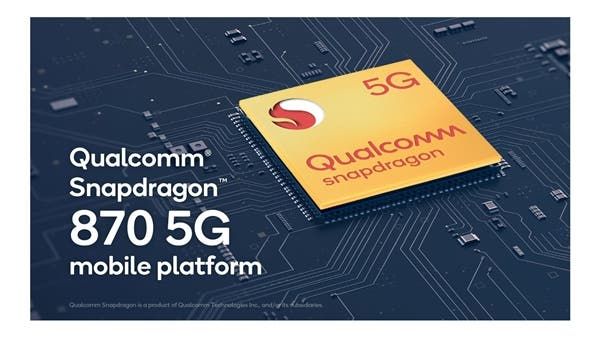
Cortex-A77 cores clocks at 3.2GHz
The new chipset has the SM8250-AC model number and brings the highest clock speed in the mobile world. The prime core now runs at 3.2GHz, up from 3.1GHz on the 865+ and 2.94 GHz on the vanilla SD865. The last year's models have been surpassed by Huawei's last chipset that reached the market with a 3.13GHz prime core. Now, Qualcomm reclaims the title of overclocking master in the mobile segment. For those who enjoy technical specifications, the new Snapdragon 870 makes use of Kyro 585 cores, which are in fact, ARM Cortex-A77 cores with some tweaks from Qualcomm. As aforementioned, the Snapdragon 888 CPU makes use of the Cortex-X1 and A78 cores. They also run at lower frequencies, and this gives space for a Snapdragon 888+ in the future, who knows?
Once again, Qualcomm is betting on the Adreno 650 GPU to ensure high-end graphical performance. However, it's unclear right now if Qualcomm has applied a clock boost or some tweaks to make it better. The Hexagon 698 and the Tensor Accelerator deliver the same 15 TOPs as the previous Snapdragon 865 chips. So no big news here as the performance in this segment may be the same.

SD870 supports 1440p displays, 8K video recording, Wi-Fi 6, and more
When it comes to the display driver, the chipset can run 1440p panels at up to 144Hz or 4K resolution at up to 60Hz. Just like other high-end offerings, the Snapdragon 870 supports HDR10+. The Spectra 480 ISP is the same inside old models, it offers support for sensors up to 200MP, 8K video capture at 30 fps, or 4K at 120 fps. The chipset also comes with the same FastConnect 6800 as the vanilla 865. It ensures Wi-Fi 6 and Bluetooth 5.2 with aptX Voice and Adaptive. Interestingly, it is down from the Snapdragon 865+ that comes with a FastConnect 6900, which offered Wi-Fi 6E. Just like other chips in Qualcomm's high-end spectrum, the Snapdragon 870 does not come with an integrated 5G modem. Instead, the chipset is paired with the Snapdragon X55 with sub-6 and mmWave support.
Current 5G Smartphones
- None (Motorola Edge S is set to premiere this chip)
- Xiaomi and Oppo are confirmed to use this chip


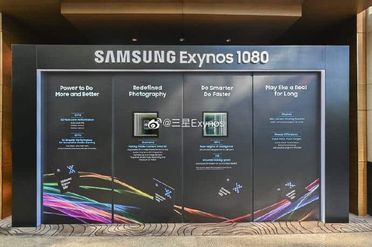
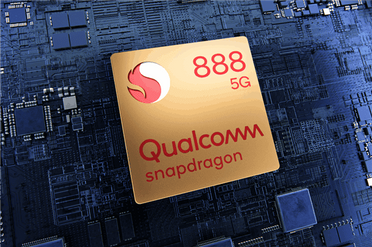
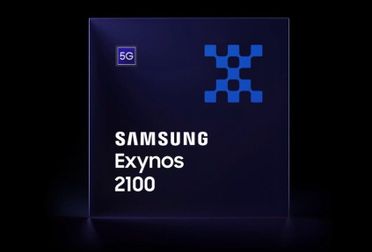

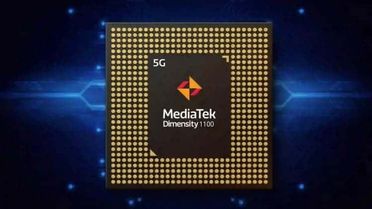
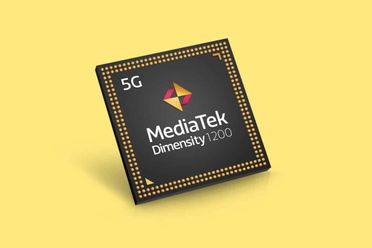




Place comments
0 Comments
You are currently seeing only the comments you are notified about, if you want to see all comments from this post, click the button below.
Show all comments